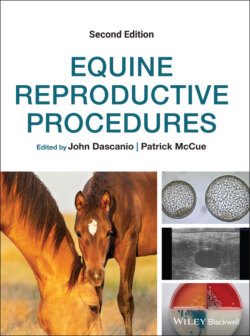Читать книгу Equine Reproductive Procedures - Группа авторов - Страница 30
Оглавление15 Microbiology: Gram Stain
Jillian Bishop1 and Patrick M. McCue2
1 University of Kansas Health System, USA
2 Equine Reproduction Laboratory, Colorado State University, USA
Introduction
Gram staining is one of the initial steps used in the identification of bacterial organisms. The technique takes advantage of the chemical differences between bacterial cell walls, thereby making this a differential stain. Gram‐positive bacteria stain a purple color due to the thick peptidoglycan layer and teichoic acids in the cell wall. This allows the bacteria to retain the primary stain once combined with the mordant, Gram iodine. The iodine reacts with the crystal violet that has already entered the cell, forming a large chemical complex that is not easily washed out of the cell.
Gram‐negative bacteria stain a pink/red color since the cell wall contains a thinner peptidoglycan layer and an outer membrane of lipopolysaccharides. These characteristics of Gram‐negative bacteria do not allow the cell to retain the crystal violet/Gram iodine complex after excess stain and mordant are rinsed off with water and the slide is decolorized using an isopropyl alcohol and acetone mixture. The alcohol dissolves parts of the lipid component of the outer membrane of the cell wall, creating “holes” in the cell membrane. Also, the much thinner and less complex peptidoglycan layer in the cell wall allows for the cell wall to be “leaky,” thus allowing the stain complex to be rinsed out of the cell. A secondary stain, safranin, is added to the smear to allow for visualization of the otherwise colorless Gram‐negative bacteria.
The most common Gram‐positive bacteria cultured from the equine uterus are Streptococcus equi subspecies zooepidemicus and Staphylococcus aureus. The most common Gram‐negative bacteria are Escherichia coli, Pseudomonas aeruginosa, and Klebsiella pneumoniae.
Equipment and Supplies
Glass slides (frosted), Gram stain kit with stabilized iodine, pencil, laboratory flame burner, deionized water in a squirt bottle, microscope, immersion oil.
Technique
Label a glass slide with the mare’s ID using a pencil.
Use an inoculating loop to add 1 drop of deionized water to the slide.
Use a sterile inoculating loop to pick up an isolated colony from the tryptic soy agar (TSA) side of the split plate and mix with the water on the slide. Use the loop to smear the mixture across the slide.
Air‐dry the slide completely.
Heat‐fix the slide by passing through a flame several times.
Cover the dried and heat‐fixed slide with crystal violet solution. Leave the stain on for 1 minute.
Gently wash off the stain with a squirt bottle of deionized water. Be careful to spray the water around the smear, not directly on the smear, or the smear may rinse off.
Cover the smear with Gram iodine solution. Leave the stain on for 1 minute.
Gently wash off the iodine with the deionized water.
Decolorize the slide using the Gram stain decolorizer. Hold the slide at an angle over the staining pan/bottle. Slowly dispense a few drops of decolorizer above the smear so that the decolorizer runs down over the smear. Blot the decolorizer that accumulates in the lower corner of the slide on a paper towel. The blotted decolorizer will be purple/blue in color at first. Apply more decolorizer, as above, just until the blotted decolorizer is colorless.Figure 15.1 Gram‐positive cocci in chains (Streptococcus equi subspecies zooepidemicus).
Gently wash off the decolorizer with deionized water.
Shake off any excess water, then cover the smear with the safranin solution. Leave the stain on for 1 minute.
Gently wash off the safranin stain with deionized water.
Gently blot the slides dry, using bibulous paper.Figure 15.2 Gram‐negative rods (Escherichia coli).
Examine the stained smear with a compound microscope under oil immersion using the 100× objective.
Interpretation
Organisms staining dark blue or purple are Gram‐positive (Figure 15.1). Organisms staining pink to red are Gram‐negative (Figure 15.2).
Further Reading
1 Reddy CA, Beveridge TJ, Breznak JA. 2007. Methods for General and Molecular Microbiology, 3rd edn. Washington, DC: ASM Press.
2 Songer J, Post K. 2005. General principles of diagnosis. In: Veterinary Microbiology Bacterial and Fungal Agents of Animal Disease. Amsterdam: Elsevier, pp. 10–20.
